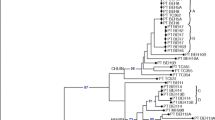Abstract.
The Vavilov Institute of Plant Industry (VIR) keeps a living seed collection of about 700 accessions of landraces and local cultivars of common vetch (Vicia sativa L.) that have been collected over a period of more than 50 years throughout the former USSR. Much of the material is available nowhere else. The collection of this economically important fodder crop is well adapted to the various growing regions of Russia and serves as a basis for the all domestic vetch breeding programs. Using AFLP as a DNA fingerprinting method we investigated 673 accessions from the VIR and compared their genetic variability with that of the worldwide vetch collection of the Institut für Pflanzengenetik und Kulturpflanzenforschung (IPK), 450 accessions. The analysis is a first assessment of the intra-specific diversity of V. sativa stored ex situ on a scale of more than 1,000 accessions. Six primer combinations, which gave clear polymorphic amplification products with 96 test samples, were chosen from 111 primer combinations tested. The selected AFLP primers used to analyse the V. sativa intra-specific diversity resulted in 70 unequivocally recognizable polymorphic fragments. We found that all of the AFLP fragments generated can be detected with varying frequency throughout the entire distribution area of V. sativa. The difference in frequency of some AFLP fragments between the regions may amount to 90%. The arrangement of most of the accessions in all dendrograms reflects their geographical origin, with a differentiation between Russia, Western Europe, Turkey and Bulgaria, and the Mediterranean. The "Russian" genepool stored at the IPK is a limited and biased sample of the available diversity when compared to the material stored at the VIR. Approximately 10–15% of the accessions in each geographical group showed AFLP patterns that clustered with members of other groups. This appreciable overlap raises several questions: (1) to which degree is an AFLP pattern representative of the overall genetic similarity of the samples; (2) to which degree are samples collected at a site adaptively limited to that site? Since our data identify accessions with very similar AFLP patterns from very diverse geographic origins, a comparison of the agronomic performance of these accessions (possibly in the two regions) will provide important information for the utilization of ex situ germplasm collections.
Similar content being viewed by others
Author information
Authors and Affiliations
Additional information
Electronic Publication
Rights and permissions
About this article
Cite this article
Potokina, .E., Blattner, .F., Alexandrova, .T. et al. AFLP diversity in the common vetch (Vicia sativa L.) on the world scale. Theor Appl Genet 105, 58–67 (2002). https://doi.org/10.1007/s00122-002-0866-8
Received:
Accepted:
Issue Date:
DOI: https://doi.org/10.1007/s00122-002-0866-8




